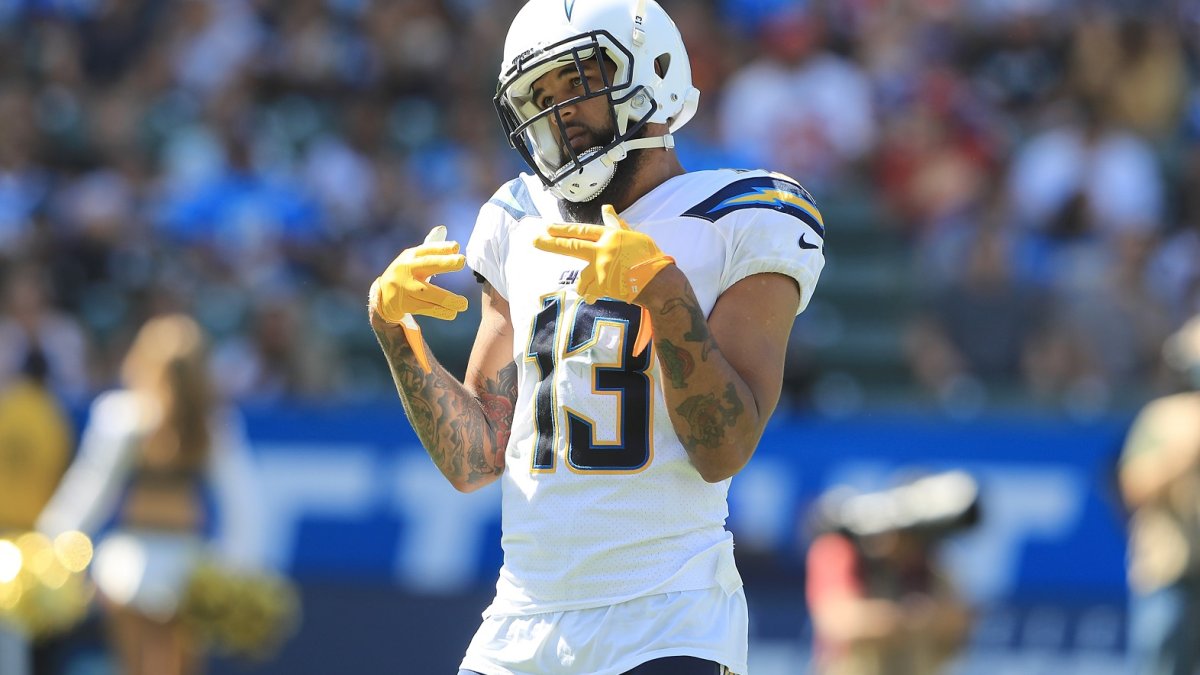The Los Angeles Chargers have reportedly signed wide receiver Keenan Allen to a four-year, $80-million extension Saturday, making him the second-highest-paid receiver from an APY perspective. Allen has been one of the best receivers in the NFL since joining the league in 2013, earning the 10th-most PFF Wins Above Replacement (WAR) at the position despite playing only the 19th-most snaps during that period.
Allen’s deal is impressive considering his designation as a slot receiver, arguably as impressive as fellow Charger Joey Bosa’s jaw-dropping $27 million per year deal that made him the highest-paid defensive player in the NFL. His alignment splits are noticeably different from his peers at the top of the wide receiver market. Julio Jones remains atop the market, with Allen now second, and Amari Cooper and Michael Thomas close behind. Here are their splits over the last two seasons:
| Player | Slot % in 2018-19 | Wide % in 2018-19 |
| Allen | 49% | 51% |
| Jones | 18% | 82% |
| Cooper | 22% | 78% |
| Thomas | 25% | 75% |
Allen’s contract landing among these receivers could cause the NFL to blur the designation between wide receivers based on where they primarily operate from. A non-wide-receiver comparison would be if the Green Bay Packers’ Kenny Clark signed a deal in the $20 million per year range like the Kansas City Chiefs’ Chris Jones even though he is known primarily as a run-stuffing nose tackle and just happens to have solid upside as a pass-rusher. Clark still signed a sizable extension at $17.5 million per year with the Packer — other nose tackles like the Philadelphia Eagles’ Javon Hargrave signed a $13.5 million per year deal this offseason, and Chicago Bears nose tackle Eddie Goldman signed a $10.5 million per year extension in 2018.
In theory, Allen would be looking to improve upon Adam Thielen’s $16.2 million per year deal from 2019 or Jarvis Landry’s $15.1 million per year deal from 2018. You would guess then that perhaps a reasonable number on a per-year basis was $18.5 million per year. Instead, he has bridged the divide between traditional outside wide receivers and predominantly slot receivers.
Slot wide receivers and slot corners for the longest time have been viewed as inferior players or as having more replaceable skillsets, but this contract goes a long way in dispelling that notion, with teams possibly wising up to the value of throwing to interior positions. It will be interesting to see if the slot cornerback market responds at all when the time comes, currently Detroit Lions‘ Justin Coleman leads the way there at $9 million per year. One thing is for sure, the value of playmakers in the passing game, no matter the style, is not lost on NFL teams.
Speaking to this, Allen is one of the most valuable players at his position in the NFL because he operates in one of the most valuable places — the middle of the field — and can separate. Only 18.4% of his targets a season ago were contested, one of the lower marks among qualifying lead receivers in 2019.
Allen will be counted on even more in 2020 than he was in previous years without the services of Hall-of-Fame quarterback Philip Rivers. We are not particularly high on rookie quarterback Justin Herbert, and he was unable to unseat journeyman Tyrod Taylor during his first training camp as an NFL passer. Our fantasy projections have Allen failing to eclipse 1,000 yards for the first time since 2016, when he was injured in the first game of the season against Kansas City. The Chargers are betting that he can elevate the play of weaker quarterbacks in 2020 – we are a bit more skeptical.
This deal affects two teams in the NFC North the most: Detroit and Chicago. Kenny Golladay and Allen Robinson are both younger than Allen and coming off of very productive seasons. It will be interesting to see when these two get deals done, and what they end up garnering.



 © 2024 PFF - all rights reserved.
© 2024 PFF - all rights reserved.